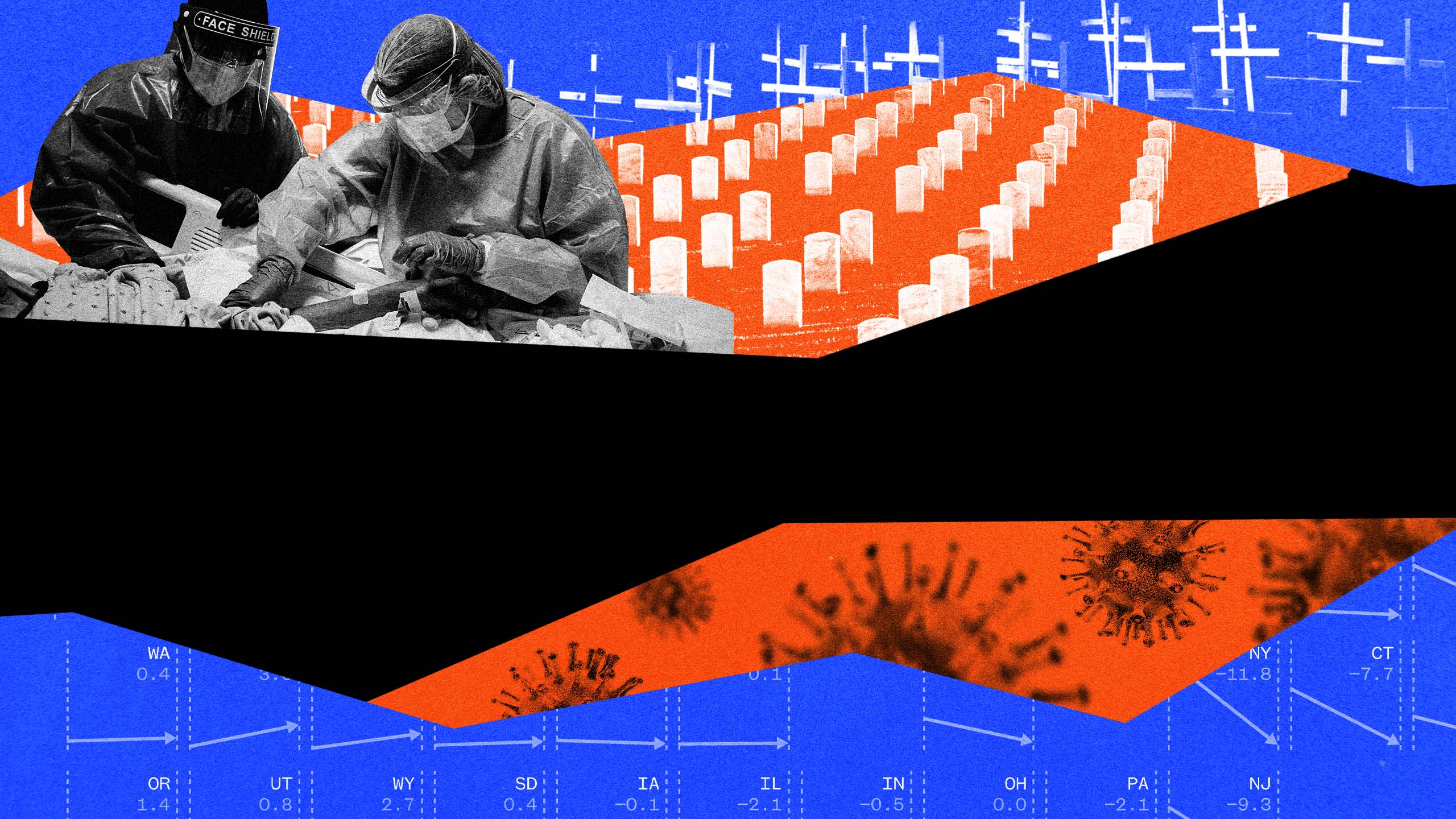The new faces of Covid deaths
The most recent group of 100,000 deaths is very different from the first, showing how the disease has shifted. And most were preventable.

By Denise Chow, Joe Murphy, Jiachuan Wu and Francisco Dans
Nov. 2, 2021
Younger, Southern, rural and white.
Those are increasingly the kinds of people who are dying of Covid-19, as the demographics of those hit hardest by the coronavirus have shifted since the pandemic first hit the United States. The country’s most recent, devastating Covid wave, fueled by the highly contagious delta variant, showed the strength of the virus even in the face of mounting vaccinations, with more than 100,000 deaths reported in the past three months.
Many of those deaths were reported in places — and in populations — that had been largely spared the worst effects of the disease until now.
An NBC News analysis of what changed from the first 100,000 Covid deaths in the U.S. to the most recent 100,000 deaths shows key geographic and demographic shifts in the evolution of the pandemic. Covid hot spots moved from densely populated cities concentrated in the Northeast and on the West Coast to Southern states and more rural regions. The disease also shifted from disproportionately affecting older adults and people with underlying conditions into a more indiscriminate killer among those who were unvaccinated.
They are deaths that were largely preventable.
“This has become a disease of the unimmunized,” said Dr. James Conway, a pediatric infectious disease specialist at the University of Wisconsin-Madison and associate director for health sciences at the school’s Global Health Institute.
The delta variant tore through the South, in particular, where vaccination rates have lagged, especially in more rural regions. Florida, Mississippi, Alabama, Louisiana, and West Virginia were among the states that experienced the biggest spikes in Covid death rates during the most recent wave.
From the first 100,000 deaths to the latest, Florida saw the largest rise in its share of population-adjusted Covid deaths, increasing by nearly 4 percentage points. NBC News’ analysis looked at each state’s Covid death rate adjusted for population and focused on how each state’s share of the country’s overall deaths changed over time. Adjusted for population, Florida’s rate of recent Covid deaths grew sixfold. Among the states with the largest increase in their share of population-adjusted deaths during the most recent surge, Southern states made up eight of the top 10.
How the pandemic spread
NBC News tracked reported Covid deaths since the start of the pandemic. Visualized here are the share of a state's population-adjusted Covid deaths and how that share changed from the first 100,000 deaths to the latest 100,000 deaths.
- New York had the largest share of Covid deaths in the country’s first 100,000 fatalities. In the most recent 100,000, Covid deaths were largely concentrated in the South.
- Cities bore the brunt of the first wave, but the latest 100,000 Covid deaths were more distributed and hot spots shifted to more rural regions.
- Among the first 100,000 deaths, people ages 75 and older made up 83 percent of the population-adjusted fatality rate. The share of middle-aged and older adults, especially those 55 to 74 years old, increased in the most recent Covid deaths.
- White people made up a much greater share of the most recent deaths compared to the first 100,000 deaths.
- Unvaccinated individuals represented the overwhelming majority in the most recent deaths. Vaccines were not yet available when the U.S. recorded its first 100,000 Covid deaths.
The first 100,000
States in the Northeast were the first to get hit hard by Covid. New York accounted for more than one out of ten Covid deaths, adjusted for population.
The latest 100,000
Since the start of the pandemic, deaths have spread across the country. Still, Southerners represent a disproportionate number of Covid deaths.
More than 730,000 people in the U.S. have died of Covid, and while the most recent surge of infections appears to be subsiding, forecasters estimate that the country could still see 50,000 more deaths from the coronavirus by the end of the year.
New York was the epicenter of the health crisis during the pandemic’s first wave. The state had the largest share of fatalities in the country’s first 100,000 deaths, even when adjusted for population. And its largest city was the hardest hit.
How the state death rate shifted
New York saw the largest percentage point decline, Florida, the largest increase from the first 100,000 Covid deaths to the latest 100,000 deaths.
Though Covid deaths in the most recent wave were largely concentrated in the South, they were more widely distributed than in the first 100,000 deaths. Unlike in the first wave of deaths, no single state made up more than 5 percent of the share of population-adjusted deaths, and only 17 states made up less than 1 percent of the country’s latest 100,000 deaths, compared to 29 states in the first wave.
Black people and white people make up outsize shares
There were also important differences in the racial and ethnic makeup of the country’s recent Covid deaths. Black people and Native Americans were disproportionately affected by Covid last year, but white people made up a much greater share of the most recent deaths compared to the first 100,000 deaths, according to data from the National Center for Health Statistics.
White people’s share of Covid deaths grew by more than 16 percentage points, jumping from around 15 percent in the first 100,000 deaths to 32 percent as of the week ending Sept. 4. The share of deaths among Black people dropped by 10 percentage points in the same period, while Latinos’ share of Covid deaths increased by approximately 5 percentage points.
The shift reflects how access to and views of the vaccines within communities have changed over the course of the pandemic, said Katelyn Jetelina, an epidemiologist and assistant professor at the University of Texas Health Science Center at Houston.
“In the beginning, when we started polling Americans about if they’re going to get vaccinated, the biggest wait-and-see group was Black and Hispanic adults,” she said. “The biggest ‘no, I will never get a vaccine’ group was white. What that’s telling me is that slowly but surely, Blacks and Hispanics are getting more and more comfortable with the data and seeing more people get the vaccines.”
In the U.S., 79 percent of adults have received at least one vaccine dose, according to the Centers for Disease Control and Prevention. Among those who remain unvaccinated, an analysis published Oct. 6 by the Kaiser Family Foundation found significant racial differences.
Conway said the race and ethnicity trends are notable, but added that it’s challenging to tease out precisely what may be driving those differences. Vaccine hesitancy, for instance, can’t solely explain differences in vaccination rates.
“It’s easy to blame it on attitudes within certain communities or issues of trust, but access is also a big issue,” he said. “And it’s not just access to vaccines or health care systems, but does your employer give you time off to actually go get vaccinated? If you don’t feel well after the second dose, can you actually take time off?”
The political factor
Politics have also played an outsize role. Differences in vaccination rates among states largely fall along political lines, with Democratic-led states broadly outperforming Republican-led counterparts. In some Republican-controlled states, such as Florida and South Dakota, governors have resisted enacting lockdowns to slow the spread of the virus, or opposed other mitigation measures, including mask mandates.
Florida Gov. Ron DeSantis, for instance, has opposed vaccine passports and issued an executive order over the summer banning mask mandates in schools and threatened to punish school districts that defied the order. The ban ignited a back-and-forth legal battle in the state over the issue, despite a punishing summer with multiple consecutive days of more than 20,000 new reported cases, grim milestones that shattered the state’s records for daily cases.
Other Republican governors, including Texas Gov. Greg Abbott, Arizona Gov. Doug Ducey, Iowa Gov. Kim Reynolds and Nebraska Gov. Pete Ricketts have been similarly outspoken against mask mandates, even after the CDC updated its guidance to encourage mask use to slow the spread of the delta variant.
“It’s very clear that this has become a political issue, not a public health issue,” Jetelina said.
Despite cases and deaths among prominent conservatives — including at least five conservative radio hosts who were critical of mass inoculation efforts but died after contracting Covid — political divides persist in vaccination rates.
Yet, politics are still only one piece of the puzzle, Conway said.
“There are also racial differences in these areas, urban versus rural things to consider, and variations in health and comorbidities in the populations,” he said. “Whatever the equation is, those things are all part of the calculus and play a role.”
Younger people are dying of Covid
Younger age groups, especially those 55 to 74 years old, made up the bulk of the most recent Covid deaths, a distinct trend compared to earlier stages of the pandemic.
Among the latest 100,000 to die of Covid, middle-aged people account for a larger share of the deaths when adjusted for population. Among the first 100,000 deaths, those 75 and older made up more than 75 percent of the population-adjusted share of deaths.
In a tally of the first 100,000 Covid deaths in the U.S., when vaccines were not yet available, people ages 75 and older made up 83 percent of the fatalities. In the most recent 100,000 deaths, however, that share fell by nearly 20 percent, with those 75 and older making up around 66 percent of the population-adjusted share of Covid deaths in the country.
Younger and middle-aged adults instead bore the greatest burden of recent coronavirus deaths. The share of people ages 35 to 54 and those 55 to 74 years old who died of Covid increased by 6 and 10 percentage points, respectively.
That demographic shift was driven by differences in vaccination rates and behavioral differences among age groups, said Ali Mokdad, a professor of global health at the University of Washington. Younger adults tend to have more social contacts than seniors and are more likely to engage in riskier behaviors with greater potential for exposure to the coronavirus, he added.
In a tally of the first 100,000 Covid deaths in the U.S., when vaccines were not yet available, people ages 75 and older made up 83 percent of the fatalities. In the most recent 100,000 deaths, however, that share fell by nearly 20 percent, with those 75 and older making up around 66 percent of the population-adjusted share of Covid deaths in the country.
Younger and middle-aged adults instead bore the greatest burden of recent coronavirus deaths. The share of people ages 35 to 54 and those 55 to 74 years old who died of Covid increased by 6 and 10 percentage points, respectively.
That demographic shift was driven by differences in vaccination rates and behavioral differences among age groups, said Ali Mokdad, a professor of global health at the University of Washington. Younger adults tend to have more social contacts than seniors and are more likely to engage in riskier behaviors with greater potential for exposure to the coronavirus, he added.
As of Oct. 15, 81 percent of people in the U.S. who are 75 and older have received vaccinations — either the two-shot Moderna or the Pfizer-BioNTech vaccines or the single-shot Johnson and Johnson vaccine — compared to 58 percent of people between 25 and 39 years old and 53.8 percent of people ages 18 to 24 years old, according to the CDC.
“We’re seeing hesitancy run rampant in the younger age groups,” Jetelina said. “So they’re not getting vaccinated and they’re filling that gap in mortality that the 65-plus group is not filling because they are protected now.”
Throughout the global health crisis, the U.S. remained one of the hardest-hit countries — even after vaccines were available to its residents — and the nation’s overall death toll is the highest in the world. The coronavirus has also killed more people in the country than during the 1918 Spanish flu pandemic, making it the deadliest pandemic in American history.
Researchers at the University of Washington’s Institute for Health Metrics and Evaluation, which produces one of the most widely cited models of the coronavirus pandemic, are projecting that based on the current situation, the country could see nearly 788,000 deaths from Covid by Jan. 1, 2022.
It’s an unthinkably high number, given the effectiveness of the available vaccines, Jetelina said, but it’s also a reminder that people should not become complacent.
“It’s exhausting and frustrating because it’s been almost two years and we know what works,” she said. “I’m optimistic that this may have been our last big wave, but of course ultimately we don’t really know.”



